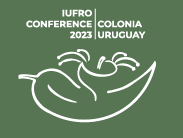Unleashing nature's potential of Corymbia
Development of commercial genotypes and adaptation of populations for the forestry industry
DOI:
https://doi.org/10.31285/AGRO.27.1245Palavras-chave:
recurrent selection, hybridization, clone, wood quality, spotted gumResumo
The PCMF|IPEF's Corymbia Project aims to develop commercial genotypes and adapt populations of Corymbia species. These species are considered a promising option for diversification in forestry, addressing the increasing biotic and abiotic challenges. Moreover, they serve as a valuable raw material for the forestry industry, including cellulose, panels, solid wood and charcoal-based steel production. The initial phase of the project involved obtaining germplasm from old populations in Brazil, such as Corymbia citriodora (CCC) and C. torelliana (CT), as well as importing less-distributed species in Brazil, like C. henryi (CH), C. maculata (CM), and C. variegata (CCV). Simple and triple crosses were performed among these species to enhance the diversity of hybrids within the evaluated genus. The ongoing work includes obtaining hybrids through controlled or spontaneous pollination, enriching the genetic base with imported materials from Australia, calibrating nutrition, studying the stability and adaptability of productivity in different environments, monitoring pests and diseases, and evaluating wood quality. Promising results have been achieved thus far. C. torelliana exhibited the highest survival rate, surpassing 95% in all experiments, even under contrasting climatic conditions. In terms of volumetric growth, C. variegata and C. henryi outperformed Eucalyptus urophylla, the country's main cultivated species, in some locations. The basic density of CCV, CCC, and CH species exceeded 600 kg per m³ at 6 years of age. Concerning cellulose production, C. variegata and C. henryi demonstrated an Average Annual Cellulose Increment exceeding 12 tons per hectare per year in the most productive location. For charcoal production, the specific consumption ranged from 4.7 m3 (CH) to 4.9 m3 (CCV) per ton of charcoal. The next steps involve evaluating survival, volumetric growth, and genetic parameters of C. citriodora (F1), C. henryi (F1), and C. torelliana (F2) progenies in at least 10 different Brazilian environments. The objective is to advance to the next generation of species improvement, including the cloning of transgressive individuals, primarily the hybrids obtained in the project's initial stage, which were established in early 2023.
Downloads

Downloads
Publicado
Como Citar
Edição
Seção
Licença
Copyright (c) 2023 Agrociencia Uruguay

Este trabalho está licenciado sob uma licença Creative Commons Attribution 4.0 International License.
| Métricas do artigo | |
|---|---|
| Vistas abstratas | |
| Visualizações da cozinha | |
| Visualizações de PDF | |
| Visualizações em HTML | |
| Outras visualizações | |















